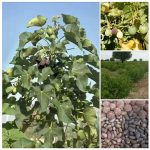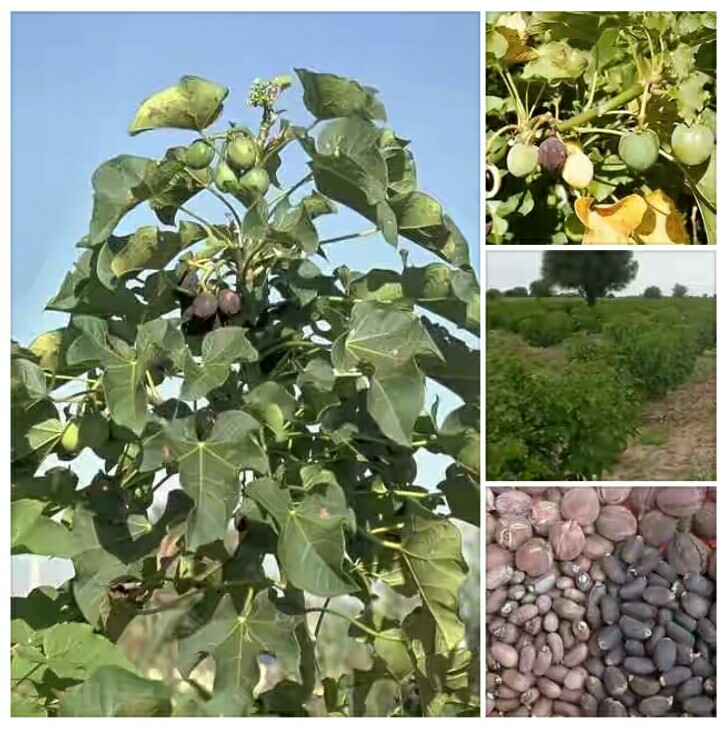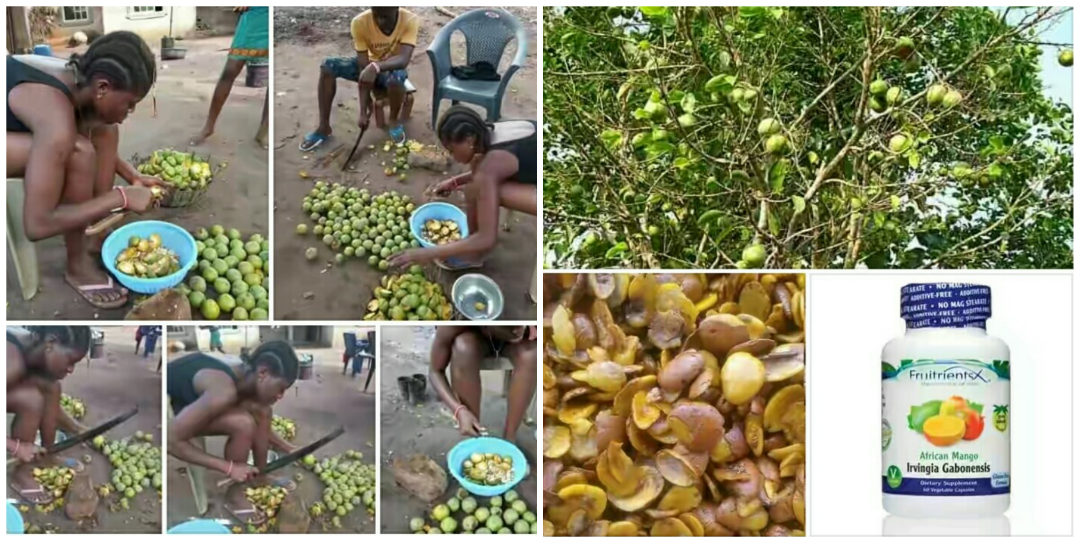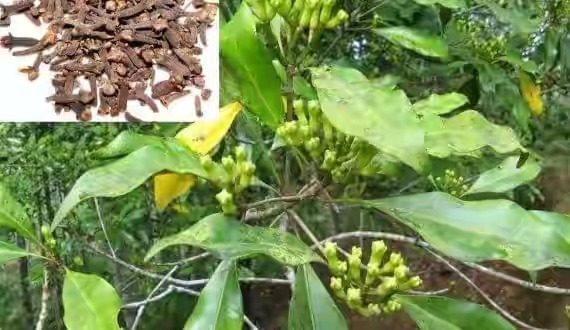Jatropha curcas L. (synonym: Jatropha afrocurcas Pax)(Botanical name)) or Barbados nut, Barbados nut tree, Bed bug plant, Big purge nut, Black vomit nut, Brazilian stinging nut, Bubble bush, Chinese castor oil, Cuban physic nut, Fig nut, Curcas, Curcas bean (English) or Bilit (Ngas) or Gàrà (Berom) or Kwolkwolaje (Fula-Fulfulde) or Halallamai, Bíí ní dà zúgúú, Cìì ní da zúgúú from zúgúú: a shroud; suggesting danger from its use (Hausa) or Bulu olu, Olulu-idu (Igbo) or Botújẹ̀, Lóbòtújẹ̀ pupa, làpálàpá (Yoruba): A multipurpose African plant
DESCRIPTION AND OCCURRENCE
Shrub or tree to 6 m, with spreading branches and stubby twigs, with a milky or yellowish rufescent exudate.
Leaves deciduous, alternate but apically crowded, ovate, acute to acuminate, basally cordate, 3 to 5-lobed in outline, 6-40 cm long, 6-35 cm broad, the petioles 2.5-7.5 cm long.
Flowers are several and sometimes many in greenish cymes, yellowish, bell-shaped; sepals 5, broadly deltoid.
Male flowers many with 10 stamens, 5 united at the base only, 5 united into a column. Female flowers borne singly, with elliptic 3-celled, triovulate ovary with 3 spreading bifurcate stigmata.
Capsules, 2.5-4 cm long, finally drying and splitting into 3 valves, all or two of which commonly have an oblong black seed, these ca 2 x 1 cm.
Though native to America, the species is almost pantropical now; it is widely planted as a medicinal plant which soon tends to establish itself.
It is listed, e.g., as a weed in Brazil, Fiji, Honduras, India, Jamaica, Panama, Puerto Rico, and Salvador. Jatropha curcas probably originated in Mexico or neighbouring parts of Central America, which are the only areas where it has often been collected from undisturbed vegetations.
Portuguese seafarers took it to Cape Verde, where it became an export crop, at one time representing 60% of the total value of agricultural exports. It was distributed all over the world long ago and is now naturalized throughout the tropics and subtropics.
Health Benefits/Uses/Importance of Jatropha curcas
In Gabon, it is grown as a support for vanilla and pepper vines. One should expect that it has a similar potential for yams. ALTHOUGH WIDELY USED IN TRADITIONAL MEDICINE, AND TO AN EXTENT IN MODERN MEDICINE, IT SHOULD BE NOTED THAT ALL PARTS OF THE PLANT ARE VERY POISONOUS AND SO EXTREME CAUTION SHOULD BE EMPLOYED IF UTILISING THIS PLANT FOR ANY INTERNAL USE.
Tender young shoots can be cooked and used as a vegetable. The young leaves may be safely eaten when steamed or stewed.
They are favored for cooking with goat meat, said to counteract the peculiar smell. The stem and twigs are used in Nigeria and in Northern Cameroon as chew-sticks, producing a kind of foam.
The watery sap is put onto fresh cuts and sores at the corner of the mouth. The young leaves are eaten in Java.
Some say that animals will not touch the leaves; others they will, but this must be rare as the leaves are reported to contain hydrocyanic acid.
An infusion, hot or cold, of the leaves is also taken internally for fever. They are mashed up by the Tenda people for poultices, and a macerate is taken as an emetic.
The Baakpe of Cameroon Mountain drink the decoction with beer as a diuretic for rheumatism, and in Nigeria an infusion of young leafy shoots is used for most urinary complaints.
In Gabon, a leaf-decoction is considered good for cleansing the kidneys and releasing bile.
In Nigeria a decoction of leaves with natron is used by women as a wash for a month before childbirth.
In The Gambia the leaves are used to make a mouth wash. MODERN RESEARCH HAS SUPPORTED THE TRADITIONAL USES. FOR EXAMPLE, THE LATEX HAS ANTIBIOTIC PROPERTIES AGAINST CANDIDA ALBICANS, ESCHERICHIA COLI, KLEBSIELLA PNEUMONIAE, STAPHYLOCOCCUS AUREUS AND STREPTOCOCCUS PYOGENS.
In Ivory Coast, heated leaves are applied to relieve pain. A compress of leaves is applied for toothache in Kordofan.
In Ghana, the leaves are commonly an ingredient in enema preparations, and are prepared, along with oil-palm fruit, for an injection administered to weakly children.
In Southern Nigeria, they are a remedy for jaundice, applied by rectal injection.
For immediate application after snake-bite, sap from the leaf is recommended in Ghana. It is said to dilute the snake-venom and to stop it from entering the blood-stream.
For emergency use herbalists recommend that leaves be charred and powdered and held in store.
The leaves are also widely used to treat guinea-worm sores as a lotion made with the crushed leaves in hot water, or by applying the ashes of burnt leaves.
In Senegal an aqueous leaf-decoction is taken by mouth for bronchitis and a decoction of dried leaves in The Gambia to relieve coughing.
The leaves and the green viscid sap are rubefacient (causing redness of the skin). Pounded leaves are applied to sluggish ulcers, and the sap of dried leaves is applied direct to cuts and bleeding wounds as a styptic.
The pounded leaf has been used in India as a repellent of house-flies and in Ghana the leaves are used to fumigate a house for bed-bugs (the Ga name meaning bed-bug tree). In Indonesia the leaf is applied to hard tumours.
In Congo (Brazzaville), the sap is instilled into the outer ear for otitis, and in Ivory Coast it is given by enema for blennorrhoea (excessive secretion and discharge of mucus) and by draught for jaundice.
The sap is given by the Tiv in the Benue Sate, Nigeria to a child with fever. Leaf-sap with water is a plaything for children who blow bubbles with it.
It can be used to make soap. It is an irritant and causes inflammation in the eyes.
It is used to put in a hollow tooth and on to bee and wasp-stings. Mixed with salt it is rubbed on teeth to clean them. Sap from the leaf-petiole or the bark is applied in The Gambia to wounds as a drying agent and antiseptic.
In India, young twigs are used as a dentifrice.
In Ivory Coast, the sap is rubbed on young children’s gums to help in teething and the latex is given to newly-born babies affected by tetanus.
The sap yields a black dye, the bark dark blue and the leaves grey.
Extracts are used as a marking-ink and dyes, and the stain is said to be indelible. But fastness was far from the case in Japanese soldiers’ uniforms dyed in a concoction of the young foliage in Thailand during World War II, 1942-45, since the colour ran in monsoon rains with grotesque results.
The latex, used in Ivory Coast for external treatment of sores, is said to contain 10% tannin and turns brown and brittle on drying.
Examination of powdered leaves of Sierra Leone material showed no alkaloid, nor saponin present, but a trace of alkaloid is reported in Indian material.
A root-decoction with natron or salt is used in West Africa for gonorrhoea and with flour for dysentery.
Root-bark, dried and pulverised, is applied as a dressing for sores, and mixed with guinea-grain is rubbed on gums to relieve the spasms of infantile tetanus.
The powdered root is taken internally for worms. In Gabon, a root-macerate is taken for spermatorrhoea (abnormally frequent or excessive emission of semen without orgasm), or pieces of the stem may be chewed for the same purpose.
The bark contains a wax which is a mixture of melissyl alcohol and its ester, myricylmelissate.
The bark is commonly used in the Philippine Islands as a fish-poison where the plant bears the same name as Derris (Leguminosae: Papilionoideae).
The dried fruits are powdered and taken with food in The Gambia as a vermifuge and to void excessive fat by inducing diarrhoea and vomiting; they are also taken for stomach-ache.
The fruit and the seed are reported to contain a contraceptive principle.
The seeds contain a palatable pleasant-tasting kernel like that of the sweet almond being a latent toxicity.
Poisoning is of the irritant type causing nausea, abdominal pain, vomiting, diarrhoea, depression and collapse.
A purgative dose is 3-4 seeds. Any more than this is dangerous. For treatment of ascites they are crushed and boiled with cereal pap, or roasted in ashes and mixed with natron or extract of wood-ashes and taken with water or milk and in Congo (Brazzaville) as many as 8 seeds per day may be given but buffered with peanuts or sugar-cane.
Seeds enter into medication for serious illnesses such as syphilis and leprosy.
For treatment of the former, seeds are crushed and mixed with cereal foods and left to ferment for two nights.
They are used by Igbo in Southern Nigeria for arthritic troubles. The crushed seed or the seed-cake in palm-oil is used in Gabon as a raticide.
In Nigeria, the seed is sometimes incorporated along with Euphorbia latex in a mixture (Gunguma, Hausa; Lówu, Nupe) to poison corn as bait for guinea-fowl. Some tribes of the Soudanian region add the nut to Strophanthus (Apocynaceae) seeds for arrow-poison.
In Sudan, the seed of a Jatropha sp., known locally as Habat el-mollok and identified on the basis of this name as J. curcas, has been found to have high molluscicidal toxicity.
The seed also has insecticidal potential. The seed is about 35% husk, 65% kernel, and the oil content of the kernel is 50-58%. The oil is semi-drying.
The seed oil is not edible as it contains toxic compounds. Traditionally, it is used for the manufacture of candles and soap, as lamp oil and as fuel for cooking. Tenda people of Senegal use the seed-oil to put a shine on pottery.
Jatropha curcas has been used in the woollen industry in England and in the preparation of Turkey Red.
The Portuguese established a plantation industry on the Cape Verde Islands to supply oil to South-West Europe, but the main planting there is to assist in reafforestation and to maintain a plant cover.
The oil is indifferent for lubrication of machinery owing to the speed with which it dries, but it is good for candle and soap manufacture.
It can be burnt as an illuminant and at one time was used for street lighting around Rio de Janeiro. It burns without smoke, and even a seed spiked on a stick and dipped in palm-oil will burn and keep alight in a strong wind.
Commercial names for the oil are: seed oil; hell oil, pinhoen oil, pulza oil, pulguiera oil, purging-nut oil, curcas oil; and pharmaceutically: oleum ricini majoris and oleum infernale.
The oil, like the rest of the plant is purgative, and its clinical use is mainly external.
IT IS THE OILY EXTRACT CALLED KUFI IN HAUSA, WHICH IS USED AS A RUBEFACIENT FOR RHEUMATIC CONDITIONS, AND FOR ITCH AND OTHER PARASITIC SKIN-DISEASES. In Yoruba, the plant is called làpálàpá, meaning ‘ringworm’, because the oil causes an irritative rash on the skin of children.
An oily preparation is applied to tumours in Mauritania and in Ivory Coast to scarifications around filaria blisters. The oil consists mainly of stearic, palmitic, myristic, oleic, linoleic and curcanoleic acids.
A phytotoxin, curcin, is present in the seed and remains in the cake on expression rendering the cake unusable as cattle-food, but it is satisfactory as a fertiliser.
This substance is related to ricin of Ricinus and to crotin of Croton tiglium.
A resin is also present in the seed and this is carried over with the oil in extraction. This is a vesicant causing redness and pustular eruptions.
There is record of the oil being used as an adulterant of cooking oils with drastic purgative effects. Ash from the burnt plant is used to produce lye for soap-making.
A vegetable salt is also extracted from the plant. Ashes from the roots and branches are used as cooking salt. Cooked nuts are eaten in certain regions of Mexico.
PROSPECTS
The multiple traditional uses of Jatropha curcas, as medicinal, nonfood-vegetable oil and auxiliary plant, have been well exploited in the tropics and subtropics for hundreds of years.
Its considerable potential as an oil crop for bio-fuel purposes at relatively low costs and modest demands on the local agro-ecosystem has received much attention in recent years.
Prospects are that within the next decade or so, Jatropha curcas will become a major source of renewable energy in the drier rural areas of (sub)tropical Asia, Africa and America.
Much agronomic and breeding work needs still to be done to maximize the oil production potential per ha and thus improve the economic sustainability of jatropha oil production.
Rapid multiplication techniques and facilities have to be developed to make improved planting material available in adequate amounts.
This is especially urgent as planting of unimproved material not only leads to low returns on investments, but may also lead to a loss of interest in this crop.
More research on Jatropha curcas should also be initiated on medicinal properties of different plant parts, e.g. wound healing, antimalarial and anti-HIV effects.
Jatropha curcas is a blood giving herb.
Investigation of the agronomic and medicinal potential of other Jatropha species would be valuable as well.

These are the thoughts and intellectual property of:
Sa’eed Halilu Bawa
Senior Lecturer (Associate Professor) at University of the West Indies, St. Augustine Campus, Trinidad.
Studied Food and Nutrition Sciences, Dietetics at Kaduna Polytechnic, Nigeria; Warsaw University of Life Sciences, Poland.
























